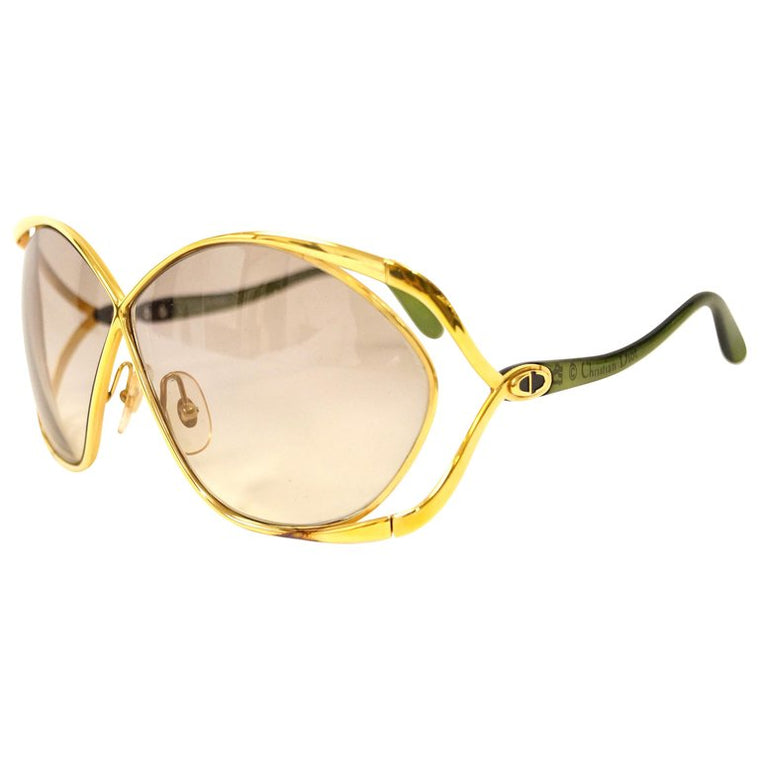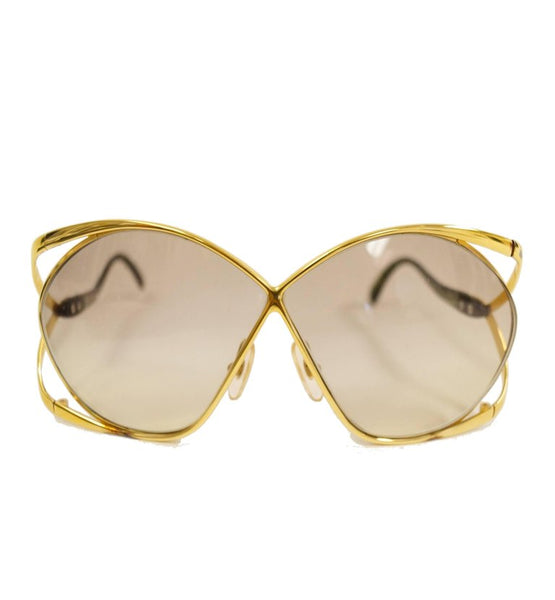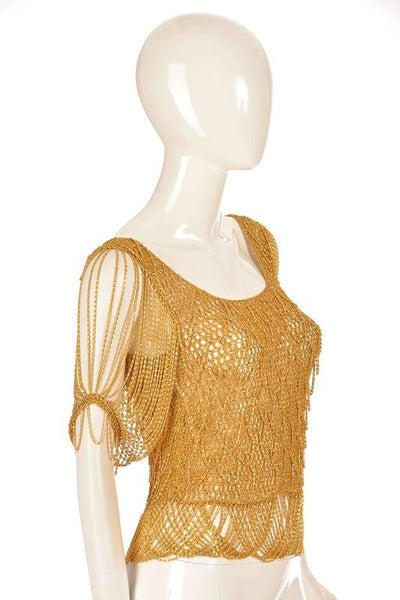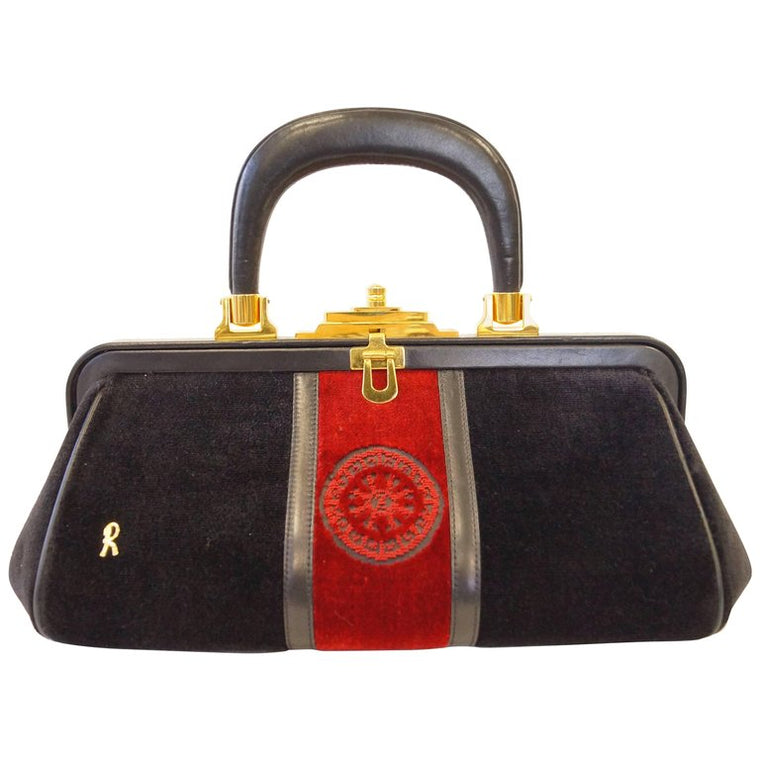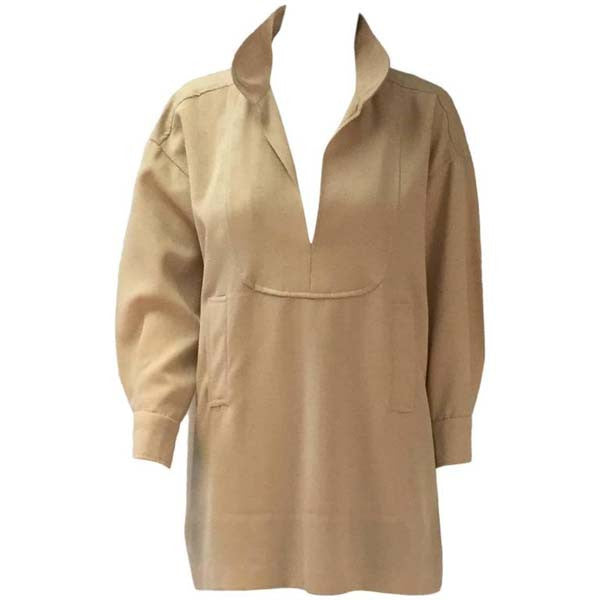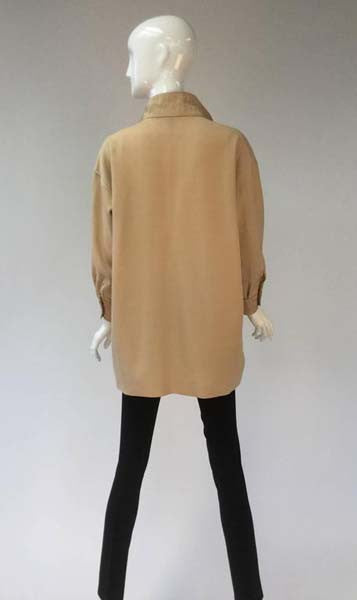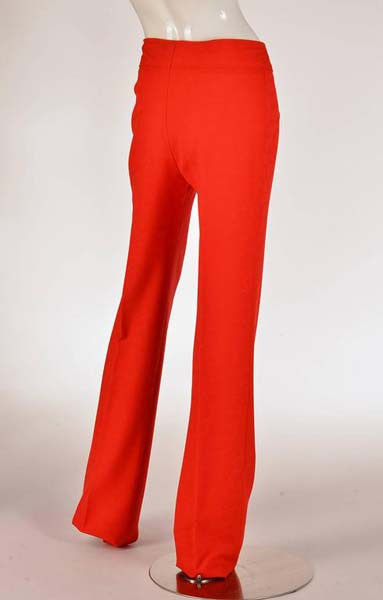1970s Roberta di Camerino Red and Blue Trompe L'oeil Midi Dress
$850.00
Amazing tromple l'oeil poly knit dress by Roberta di Camerino! The dress has a loose silhouette, with long sleeves, and a long pointed wing collar. The piece features an amazing graphic print that tricks one's eyes into thinking that the dress is actually a three piece ensemble! The print includes a black and red plaid faux skirt with pleats, a white blouse accented by gold tone Roberta buttons, and a red jacket with bright blue trim. This playful, elegant dress is deceivingly simple and wonderfully stylish! Made in Italy. Fabric is synthetic. Dress is in fair condition and missing cuff links for the french cuffs.
Giuliana Camerino (née Coen) was born to a Jewish family in Venice. In 1943, as World War II raged on, the Camerinos fled to Switzerland where Giuliana began designing handbags for local leather goods stores. Camerino founded the house “Roberta di Camerino” in 1945. The business was named after the 1935 Fred Astaire and Ginger Rogers film “Roberta”; The song “Smoke Gets In Your Eyes” was the last tune Camerino listened to before escaping to Switzerland.
Roberta di Camerino handbags quickly became known for their innovative use of patterned and colored fabric, two materials that had never been used in handbags. Camerino continued to develop new and interesting designs that would go on to inspire others, including using an “R”-trellis pattern in 1946 that predated Gucci’s iconic “G” pattern handbags and accessories, a the woven leather handbag in 1957 that anticipated the Bottega Veneta woven look, and a hinged handbag that Prada later went on to imitate. Camerino helped develop the post-WW2 venetian economy, employing venetian craftsmen to create many materials, including the brass hardware she used in her striking, cut-velvet bags, and to weave fabric using local antique looms. Camerino branched out into apparel; much of her clothing had distinctive optical illusion tromp l’oeil prints, pleats, buckles, and ruffles.
1970s Roberta di Camerino Red Trompe L'oeil Ensemble Maxi Dress
$875.00
Amazing tromple l'oeil poly knit maxi dress by Roberta di Camerino! The dress has a loose silhouette, with long sleeves, and a long pointed wing collar. The piece features an amazing graphic print that tricks one's eyes into thinking that the dress is actually a three piece ensemble! The print includes a red faux skirt with billowing pleats, a wide purple - blue belt that makes one think of Spanish matadors, a white blouse, and a red jacket with lapel and passementerie designs. This playful, elegant dress is deceivingly simple and wonderfully stylish! Gold tone Roberta buttons ornament the front, and match the cufflinks on the sleeve. Made in Italy.
Giuliana Camerino (née Coen) was born to a Jewish family in Venice. In 1943, as World War II raged on, the Camerinos fled to Switzerland where Giuliana began designing handbags for local leather goods stores. Camerino founded the house “Roberta di Camerino” in 1945. The business was named after the 1935 Fred Astaire and Ginger Rogers film “Roberta”; The song “Smoke Gets In Your Eyes” was the last tune Camerino listened to before escaping to Switzerland.
Roberta di Camerino handbags quickly became known for their innovative use of patterned and colored fabric, two materials that had never been used in handbags. Camerino continued to develop new and interesting designs that would go on to inspire others, including using an “R”-trellis pattern in 1946 that predated Gucci’s iconic “G” pattern handbags and accessories, a the woven leather handbag in 1957 that anticipated the Bottega Veneta woven look, and a hinged handbag that Prada later went on to imitate. Camerino helped develop the post-WW2 venetian economy, employing venetian craftsmen to create many materials, including the brass hardware she used in her striking, cut-velvet bags, and to weave fabric using local antique looms. Camerino branched out into apparel; much of her clothing had distinctive optical illusion tromp l’oeil prints, pleats, buckles, and ruffles.
1970s Roberta di Camerino Red Blue and White Trompe L'oeil Dress
$650.00
Striking! This slinky poly knit Roberta di Camerino dress falls below the knee, has short sleeves, and a round jewel neckline. The top of the dress is brilliant and deep Roberta red, with a navy blue trompe l'oeil illusion "fold" line that dips into the v - shape accent "belt" around the waist, giving the dress the appearance of billowing movement. The skirt of the dress features a geometric diamond, zig-sag, and rectangle pattern. A design exemplary of Roberta di Camerino's playful, elegant style! Made in Italy.
Giuliana Camerino (née Coen) was born to a Jewish family in Venice. In 1943, as World War II raged on, the Camerinos fled to Switzerland where Giuliana began designing handbags for local leather goods stores. Camerino founded the house “Roberta di Camerino” in 1945. The business was named after the 1935 Fred Astaire and Ginger Rogers film “Roberta”; The song “Smoke Gets In Your Eyes” was the last tune Camerino listened to before escaping to Switzerland.
Roberta di Camerino handbags quickly became known for their innovative use of patterned and colored fabric, two materials that had never been used in handbags. Camerino continued to develop new and interesting designs that would go on to inspire others, including using an “R”-trellis pattern in 1946 that predated Gucci’s iconic “G” pattern handbags and accessories, a the woven leather handbag in 1957 that anticipated the Bottega Veneta woven look, and a hinged handbag that Prada later went on to imitate. Camerino helped develop the post-WW2 venetian economy, employing venetian craftsmen to create many materials, including the brass hardware she used in her striking, cut-velvet bags, and to weave fabric using local antique looms. Camerino branched out into apparel; much of her clothing had distinctive optical illusion tromp l’oeil prints, pleats, buckles, and ruffles.
1950s Miriam Haskell Red Rhinestone Sunburst Floral Earrings
Sold Out
1970s Maison Gripoix for Jean Patou Poppy Red Earrings
Sold Out
1960s Hattie Carnegie Floral Gold Tone Rhinestone Entremble Earrings
$300.00
This opulent set of gold tone pearl and rhinestone earrings is indicative of the luxurious jewelry Hattie Carnegie designed in the 1950s and 1960s. The earrings features a wide spray floral design composed of various rhinestone encrusted leaves with vines curling throughout, as well as bud - like pearls and small gold flowers set onto springs. The small golden flowers tremble when worn (hence "entremble"), giving the necklace an added layer of luxury and whimsy!
The necklace has a matching necklace that feature the same rhinestone, pearl, and entremble floral design. The necklace is available for purchase. See last image for details.
Hattie Carnegie was born Henrietta Kanengeiser in Vienna, Austria-Hungary. She was the second of seven children, and lived in poverty in her youth. The family immigrated to the United States when she was still a child, and settled in Manhattan. After her father’s death in 1902, Hattie took a job as a messenger at Macy’s to help support her family, and in 1904 she modeled and trimmed hats at a millinery.
In 1909 Hattie branched out, launching a hat making business with dressmaker Rose Roth, but by 1919 Roth had left the business, leaving Carnegie as the owner of “Hattie Carnegie, Inc,” a company that had a working capital of $100,000. Carnegie began traveling to Paris to buy original dresses to both sell in her shop, and use as inspiration for her own garment and accessory designs. Carnegie was instrumental in bringing Paris fashion to the United States; she imported Lanvin, Molyneux, Patou, Schiaparelli, Vionnet, and others, lavishing New York with gorgeous garments and groundbreaking designers that would have not crossed the pond otherwise. Carnegie also discovered and nurtured the talents of many prominent American designers, including Norman Norell, Pauline Trigère, and James Galanos. In 1925, Carnegie bought a building off of Park Avenue to house her $3.5-million-a-year business, and stayed there producing pieces throughout the Great Depression.
During World War II French haute couture came to a standstill. Carnegie rose to prominence on the international stage as an authority on fashion, and her works were seen in the theatre, cinema and on magazine covers. Although still glamorous, her designs became more austere when the United States joined the Allied Powers. As a part of the war effort, Carnegie designed a dress for Life Magazine. The dress patterns were published in the magazine alongside detailed instructions; it was said that although the dress could have been made for as little as $5, the original dress was valued at $175. After the war, Carnegie continued her business, the epitome of perseverance.
Sometime in her early 20s, Hattie had taken the last name Carnegie after Andrew Carnegie, the industrialist, philanthropist, and richest man in the United States during her lifetime. She certainly lived up to the name, having worked her way through and out of an impoverished childhood and into a glamorous life doing what she loved, while still grossing millions a year. Carnegie passed away in 1956, having been instrumental in the diffusion of Parisian fashion into American society, having nurtured the finest designing minds of the early and mid 20th century, and having designed all manner of enchanting things, including hats, handbags, gloves, jewelry, furs, lingerie, cosmetics, and even perfume.
1960s Hattie Carnegie Floral Gold Tone Rhinestone Entremble Necklace
$445.00
This opulent gold tone pearl and rhinestone necklace is indicative of the luxurious jewelry Hattie Carnegie designed in the 1950s and 1960s. The necklace features a wide curved floral design composed of various rhinestone encrusted leaves with vines curling throughout, as well as bud - like pearls and small gold flowers set onto springs. The small golden flowers tremble when worn ( hence "entremble" ), giving the necklace an added layer of luxury and whimsy!
The necklace has a matching pair of earrings that feature the same rhinestone, pearl, and entremble floral design. They are available for purchase. See last image for details.
Hattie Carnegie was born Henrietta Kanengeiser in Vienna, Austria-Hungary. She was the second of seven children, and lived in poverty in her youth. The family immigrated to the United States when she was still a child, and settled in Manhattan. After her father’s death in 1902, Hattie took a job as a messenger at Macy’s to help support her family, and in 1904 she modeled and trimmed hats at a millinery.
In 1909 Hattie branched out, launching a hat making business with dressmaker Rose Roth, but by 1919 Roth had left the business, leaving Carnegie as the owner of “Hattie Carnegie, Inc,” a company that had a working capital of $100,000. Carnegie began traveling to Paris to buy original dresses to both sell in her shop, and use as inspiration for her own garment and accessory designs. Carnegie was instrumental in bringing Paris fashion to the United States; she imported Lanvin, Molyneux, Patou, Schiaparelli, Vionnet, and others, lavishing New York with gorgeous garments and groundbreaking designers that would have not crossed the pond otherwise. Carnegie also discovered and nurtured the talents of many prominent American designers, including Norman Norell, Pauline Trigère, and James Galanos. In 1925, Carnegie bought a building off of Park Avenue to house her $3.5-million-a-year business, and stayed there producing pieces throughout the Great Depression.
During World War II French haute couture came to a standstill. Carnegie rose to prominence on the international stage as an authority on fashion, and her works were seen in the theatre, cinema and on magazine covers. Although still glamorous, her designs became more austere when the United States joined the Allied Powers. As a part of the war effort, Carnegie designed a dress for Life Magazine. The dress patterns were published in the magazine alongside detailed instructions; it was said that although the dress could have been made for as little as $5, the original dress was valued at $175. After the war, Carnegie continued her business, the epitome of perseverance.
Sometime in her early 20s, Hattie had taken the last name Carnegie after Andrew Carnegie, the industrialist, philanthropist, and richest man in the United States during her lifetime. She certainly lived up to the name, having worked her way through and out of an impoverished childhood and into a glamorous life doing what she loved, while still grossing millions a year. Carnegie passed away in 1956, having been instrumental in the diffusion of Parisian fashion into American society, having nurtured the finest designing minds of the early and mid 20th century, and having designed all manner of enchanting things, including hats, handbags, gloves, jewelry, furs, lingerie, cosmetics, and even perfume.
1980s Nina Ricci Green Floral Silk Dress
Sold Out
1980s Andre Laug Red Silk Snakeskin Print Dress
$495.00
1960s Rodrigues Poppy Red Wool Mod Coat
$355.00
Fabulous bright poppy red mod shift coat by Rodrigues. The coat hits mid thigh, has long sleeves, as well as a faux turtleneck collar. The coat is single breasted, with a row of five large, glossy red buttons. The coat can be worn with a waist-cinching belt, or left loose for a playful Twiggy-like silhouette. Brilliant poppy red adds a POP of color to your winter wardrobe.
1970s Bill Blass Purple and Red Silk Evening Dress W/ Neck Tie/ Bow Detail
Sold Out
Striking 1970s maxi evening dress by Bill Blass. The dress is maxi length, with ling cuffed bishop sleeves, a cinched waist, and a turtle neckline with amazing ribbon detail. The neck features a two long strands of silk that can be tied in a bow that cascades down the wearer's back. The print of the dress features a purple and red plaid base with bright solid red printed designs swirling on top. Gorgeous and elegant.
Bill Blass grew up in Depression - era Indiana, where he sought refuge from the bitterness of life in cinemas. Blass looked up to the silver screen and found inspiration in the leading ladies and their fantastical costumes.
Blass studied at Parsons School of Art and Design in New York, funded by his winnings from a Chicago Tribune dress design contest, and later by his commissioned sketches for Seventh Avenue garment houses. Glass’ career and education were interrupted by WWII, where he was assigned to US 603rd Camouflage Battalion, a part of the famous “Ghost Army” Allied collaboration known for their creative deception techniques.
After the war, Blass remained in New York, working under Anne Klein, Anna Miller, and Maurice Rentner. In 1970, Blass purchased and renamed Renter’s firm.
Blass achieved internationally recognition when he joined the American team of designers -consisting of Stephen Burrows, Oscar de la Renta, Halston, and Anne Klein with Donna Karan- that was to face off against the French team of designers -Yves Saint Laurent, Emanuel Ungaro, Marc Bohan for Christian Dior, and Hubert de Givenchy- in the infamous “Battle of Versailles” fashion show.
Blass was well known for his couture take on sportswear. He would make traditional cuts in luxurious fabrics, with incredible craftsmanship and attention to detail. His opulent sportswear was unparalleled, and in pairing a cashmere cardigan with a silk gown, he found new innovative ways to mix it into his formalwear. Glass was also known to be very hands on with his business, lending his pieces for benefits, and touring and making appearances in department stores that were putting out his new lines.
Clients include: Barbara Streisand, Barbara Walters, the Barbaras Bush, Happy Rockefeller, Gloria Vanderbilt, and Brooke Astor.
1980s Christian Dior Signature Apple Green Butterfly Sunglasses Model 2056
Sold Out
Iconic 1980s Dior butterfly sunglasses! These glamorous, feminine sunglasses showcase Dior's famous butterfly design. The apple green and gold-tone frames gently wrap around the oversized lenses. The letters "CD," for Christian Dior, sit over the temple hinges. The sunglasses were made in Austria.
Frame Width: 149.22 mm
Bridge: 6.35 mm
Temple Arm Length: 114.3 mm
Lens Height: 57.15 mm
Lens Width: 69.85 mm
*All garments and accessories have been professionally cleaned and thoroughly checked before shipping. They are ready to wear upon arrival.
*Shipping includes signature required and insured full value
1970s Loris Azzaro Gold Beaded Knit Body Jewelry Sweater Blouse
Sold Out
A simply fantastic top! This intricately woven gold-tone Chain and knit sweater has light chains incorporated into the diamond scallop weave. The sleeves of the top are delicate festooned chains, and the top features a scoop neck. The top slips overhead and is unlined. Modern US S-M *All garments and accessories have been professionally cleaned and thoroughly checked before shipping. They are ready to wear upon arrival.
2001 Stephen Jones Rose Red Felt Layered Bucket Hat, England
$455.00
Striking! Fun bright red hat by Stephen Jones! This brilliant bucket hat features a high, round crown with a wide, sloping brim giving the piece a cloche - like look. The hat is composed of five stacked layers of felt with playful asymmetric edges, making the piece look somewhat like a rose. All eyes on you!
Stephen Jones is among the leading milliners of the day, bringing hats into the modern era with interesting materials, juxtapositions of form, and unabashed attitude! Clients include: Princess Diana, Boy George, Rhianna, Katy Perry, Mick Jagger Jones has collaborated with: Rei Kawakubo, Vivienne Westwood, Claude Montana, Thom Browne, Dior.
Valentino Leather Off White Rock Studded Shoulder Bag
$900.00
1950s Roberta di Camerino Red Tapestry Evening Bag with Hand Painted Porcelain
Sold Out
This Roberta di Camerino top handle handbag is composed of a pinkish red flocked floral tapestry structured triangular body with matching thin strap, and a hand painted pink and green floral porcelain closure snap. Gold tone hardware. Handbag has leather interior with pocket, and was made solely for Neiman Marcus. An absolute jewel of a bag!
Giuliana Camerino (née Coen) was born to a Jewish family in Venice. In 1943, as World War ii raged on, the Camerinos fled to Switzerland where Giuliana began designing handbags for local leather goods stores. Camerino founded the house “Roberta di Camerino” in 1945. The business was named after the 1935 Fred Astaire and Ginger Rogers film “Roberta”; The song “Smoke Gets In Your Eyes” was the last tune Camerino listened to before escaping to Switzerland.
Roberta di Camerino handbags quickly became known for their innovative use of patterned and colored fabric, two materials that had never been used in handbags. Camerino continued to develop new and interesting designs that would go on to inspire others, including using an “R”-trellis pattern in 1946 that predated Gucci’s iconic “G” pattern handbags and accessories, a the woven leather handbag in 1957 that anticipated the Bottega Veneta woven look, and a hinged handbag that Prada later went on to imitate. Camerino helped develop the post-WW2 venetian economy, employing venetian craftsmen to create many materials, including the brass hardware she used in her striking, cut-velvet bags, and to weave fabric using local antique looms. Camerino branched out into apparel; much of her clothing had distinctive optical illusion tromp l’oeil prints, pleats, buckles, and ruffles.
Camerino’s pieces were favored as a status symbol among the jet set crowd as well as celebrities, including Elizabeth Taylor, Grace Kelly, and Farrah Fawcett. Her innovative designs in playful and exciting fabrics earned Camerino several accolades. Camerino won a Neiman Marcus Fashion Award in 1956, acknowledging the widespread influence of her designs on the entire handbag market, her work was also exhibited at the Whitney Museum of American Art in 1980, and as well as the Fashion Institute of Technology Museum in 1999.
6" Drop
1970s Roberta di Camerino Velvet Black Red Gold Top Handle Purse
Sold Out
This beautiful, luxurious, and plush handbag features the distinctive Roberta di Camerino "R" logo, situated on the lower left corner of the handbag, on one the wider black stripe. The handbag has a central red stripe nestled between two leather strips, and featuring a wonderful cut velvet radial sunburst design. The hard frame purse has a leather base, handles, and accent piping, as well as a leather lined interior. The body of the purse is primarily composed of gorgeous, soft velvet. The purse has gold tone art deco push clasp hardware. The purse was made in Italy. It is impossible to be anything less than charmed by a Roberta di Camerino handbag.
Giuliana Camerino (née Coen) was born to a Jewish family in Venice. In 1943, as World War ii raged on, the Camerinos fled to Switzerland where Giuliana began designing handbags for local leather goods stores. Camerino founded the house “Roberta di Camerino” in 1945. The business was named after the 1935 Fred Astaire and Ginger Rogers film “Roberta”; The song “Smoke Gets In Your Eyes” was the last tune Camerino listened to before escaping to Switzerland.
Roberta di Camerino handbags quickly became known for their innovative use of patterned and colored fabric, two materials that had never been used in handbags. Camerino continued to develop new and interesting designs that would go on to inspire others, including using an “R”-trellis pattern in 1946 that predated Gucci’s iconic “G” pattern handbags and accessories, a the woven leather handbag in 1957 that anticipated the Bottega Veneta woven look, and a hinged handbag that Prada later went on to imitate. Camerino helped develop the post-WW2 venetian economy, employing venetian craftsmen to create many materials, including the brass hardware she used in her striking, cut-velvet bags, and to weave fabric using local antique looms. Camerino branched out into apparel; much of her clothing had distinctive optical illusion tromp l’oeil prints, pleats, buckles, and ruffles.
Camerino’s pieces were favored as a status symbol among the jet set crowd as well as celebrities, including Elizabeth Taylor, Grace Kelly, and Farrah Fawcett. Her innovative designs in playful and exciting fabrics earned Camerino several accolades. Camerino won a Neiman Marcus Fashion Award in 1956, acknowledging the widespread influence of her designs on the entire handbag market, her work was also exhibited at the Whitney Museum of American Art in 1980, and as well as the Fashion Institute of Technology Museum in 1999.
Height: 5 1/4, Width: 11, Depth: 5 3/4, Drop: 3 1/4, Total Length: 9 1/4 inches
*All MRS Couture garments and accessories have been professionally cleaned and thoroughly checked before shipping. They are ready to wear upon arrival.
7 images Roberta di Camerino Black Leather Doctor Bag
Sold Out
Gorgeous Roberta di Camerino leather doctor bag! The handbag features the famous Roberta di Camerino belted “R” woven into the front of the bag. The bag itself is made of supple black leather tightly draped over an a-frame handbag structure in the classic “doctor bag” shape. The handbag features both a top handle and a cross body strap that can be hidden inside the bag. The interior of the piece is done in black leather and includes two pockets (one with zipper), the brand's label. The eye-catching woven”R” front brings to mind the woven leather bags Roberta di Camerino made in the 1950s and 1960s, predating Bottega Veneta's iconic woven bags by several years. It's worth noting that both Roberta di Camerino and Bottega Veneta call Venice their home... Roberta di Camerino has always been a trendsetter!
Giuliana Camerino (née Coen) was born to a Jewish family in Venice. In 1943, as World War ii raged on, the Camerinos fled to Switzerland where Giuliana began designing handbags for local leather goods stores. Camerino founded the house “Roberta di Camerino” in 1945. The business was named after the 1935 Fred Astaire and Ginger Rogers film “Roberta”; The song “Smoke Gets In Your Eyes” was the last tune Camerino listened to before escaping to Switzerland.
Roberta di Camerino handbags quickly became known for their innovative use of patterned and colored fabric, two materials that had never been used in handbags. Camerino continued to develop new and interesting designs that would go on to inspire others, including using an “R”-trellis pattern in 1946 that predated Gucci’s iconic “G” pattern handbags and accessories, a the woven leather handbag in 1957 that anticipated the Bottega Veneta woven look, and a hinged handbag that Prada later went on to imitate. Camerino helped develop the post-WW2 venetian economy, employing venetian craftsmen to create many materials, including the brass hardware she used in her striking, cut-velvet bags, and to weave fabric using local antique looms. Camerino branched out into apparel; much of her clothing had distinctive optical illusion tromp l’oeil prints, pleats, buckles, and ruffles.
Camerino’s pieces were favored as a status symbol among the jet set crowd as well as celebrities, including Elizabeth Taylor, Grace Kelly, and Farrah Fawcett. Her innovative designs in playful and exciting fabrics earned Camerino several accolades. Camerino won a Neiman Marcus Fashion Award in 1956, acknowledging the widespread influence of her designs on the entire handbag market, her work was also exhibited at the Whitney Museum of American Art in 1980, and as well as the Fashion Institute of Technology Museum in 1999.
*All garments and accessories have been professionally cleaned and thoroughly checked before shipping. They are ready to wear upon arrival.
1990s Roberta di Camerino Tan Wool Tunic
$395.00
This wonderfully plush 1990's Roberta di Camerino wool tunic is the perfect piece to take you through the colder seasons for years to come. Covered in her signature "R" the tunic features an open collar, which opens into a bib neckline. Kangaroo pocket front center of tunic. Cuffed sleeve with button.
EU Size 8 - Approximately a US Size 2-4
Hem can be lengthened 3/4 of an inch
*All MRS Couture garments and accessories have been professionally cleaned and thoroughly checked before shipping. They are ready to wear upon arrival.
Vintage Roberta di Camerino Red Wool Trousers
Sold Out
Vintage red wool trousers with Roberta di Camerino signature fabric consisting of buckles and belts printed all over the pants. Flat front. Gold metal button stamped with her logo. Zip front.
Modern Us Size 6-8. See measurements.
*All MRS Couture garments and accessories have been professionally cleaned and thoroughly checked before shipping. They are ready to wear upon arrival.

